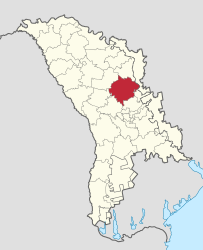Orhei district
| Orhei district | |||
|---|---|---|---|
| Symbols | |||
|
|||
| Basic data | |||
| Country | Republic of Moldova | ||
| Capital | Orhei | ||
| surface | 1094 km² | ||
| Residents | 101,502 (2014) | ||
| density | 93 inhabitants per km² | ||
| founding | 2003 | ||
| ISO 3166-2 | MD-OR | ||
| Website | or.md (Romanian) | ||
| politics | |||
| president | Ion Ștefîrța | ||
| Political party | PLDM | ||
Coordinates: 47 ° 25 ' N , 28 ° 50' E
The Orhei Rajon ( Romanian Raionul Orhei ) is a Rajon in the Republic of Moldova . The capital of the Rajons is Orhei .
geography
The Rajon is located in the center of the country on the Răut River . It borders on the Rajons Călărași , Criuleni , Rezina , Strășeni and Telenești and the breakaway region of Transnistria .
history
Orhei Rajon has existed since 2003. Until February 2003, the area belonged to the larger and now dissolved Orhei District (Județul Orhei).
population
Population development
1959 lived in the area of today's Rajons 103,809 inhabitants. In the following decades the number of inhabitants increased steadily: from 126,204 in 1970 to 129,406 in 1979 to 131,471 in 1989. By 2004, as in the whole of Moldova, the population of the Rajon fell, which was 116,271 in that year. In 2014 it was 101,502.
Ethnic groups
According to the 2004 census, the Moldovans make up the proportionately largest ethnic group in Orhei Raion with 86.4%, followed by the Romanians with 7.1%, the Ukrainians with 3.9% and the Russians with 1.9%. Smaller minorities are the Gagauz and Bulgarians with 0.1% each.
Culture and sights
The medieval settlement area of Orheiul Vechi ("Old Orhei"), which covers several dozen hectares, is the largest tourist attraction in Moldova. In the local village of Butuceni there is an archaeological and folklore museum.
In the village of Ivancea was a museum complex founded under the auspices of the National Museum of Ethnology and Natural History with a collection of Moldovan handicrafts, which was closed due to financial problems. Since 1976, a museum has been housed in the birthplace of the fable poet and translator Alexandru Donici (1806–1865) in the village of Donici.
The Curchi Monastery in the municipality of Vatici with a Neo-Byzantine and a Classicist church is an important architectural monument of the 18th and 19th centuries.
Web links
Individual evidence
- ↑ a b http://www.statistica.md/public/files/Recensamint/Recensamintul_populatiei/vol_1/1_Toate_recensaminteleRne_ro.xls
- ^ Moldova: administrative structure (districts and municipalities) - population figures, graphics and map. Retrieved May 9, 2018 .
- ↑ http://www.statistica.md/public/files/Recensamint/Recensamintul_populatiei/vol_1/6_Nationalitati_de_baza_ro.xls




